Pennsylvania
When England acquired New York in 1664, it also gained land to the south. In 1681 King Charles II repaid a £16,000 debt by giving William Penn a land grant in the New World Colonies. Penn, a Quaker, named the land grant Pennsylvania (‘Penn’s Wood’) in honour of his father, Admiral Penn. By 1684 Penn had set up the Quaker Province of Pennsylvania. Nearly 100 years later, Pennsylvania was at the centre of attempts to defend the rights of Colonists. When those attempts failed it became the political centre for the the movement towards American independence and the site of many battles in the 1775-83 Revolutionary War. Pennsylvania also played a key role in the 1861-65 Civil War with bloody battle at Gettysburg often seen as the turning point of the war.
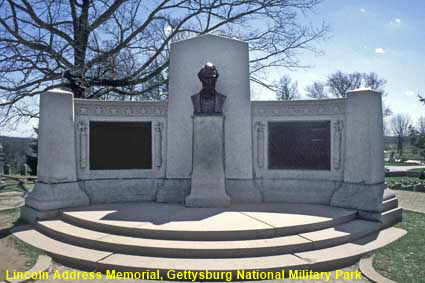
Lincoln Address Memorial, Gettysburg National Military Park
In 1863 Confederate General Robert E Lee decided that the way to end the Civil War would be to invade the north. On July 2nd Confederate troops met Union troops at Gettysburg for one of the bloodiest battles of the war that over 3 days left 51,000 dead, wounded or missing and the Confederates in retreat. Over 3,500 civil war soldiers are buried here. In November 1863 President Lincoln visited the site for the consecration of the Cemetery and delivered his famous address that ended “......and that this government of the people, by the people, for the people, shall not perish from the earth. "
Washington's HQ, Valley Forge NHP
Harsh winters in the North American Colonies were not good for fighting a Revolutionary War so in December 1777 General George Washington took the 12,000 men of his Continental Army to Valley Forge, around 35 kilometres (22 miles) from Philadelphia. Here the army stayed for 6 months, building wooden huts to protect themselves from the weather. Food was scarce, but by June 1778 the Continental Army was ready to march off to fight the British. The site of the encampment is now Valley Forge National Historic Park. General Washington did not live in a log cabin, but rented the Isaac Potts house from its occupant, Mrs. Deborah Hewes. Click Tab 2 to see the recreation of Washington’s office.
The Liberty Bell, Philadelphia
Probably the greatest symbol of Philadelphia’s role in establishing the USA, the Liberty Bell was made in the Whitechapel Foundry in London in 1752. It cracked on the day in 1753 that it was hung. It was recast, but cracked again in the mid 19th century. It achieved its symbolic place in American history on July 8, 1776 when it was used to summon the citizens of Philadelphia to the first reading of the Declaration of Independence. Behind the bell can be seen the tower of Independence Hall which was originally constructed as the State House for the then Province. It’s role in US History was secured when Declaration of Independence was adopted in the Assembly Room of the hall on July 4, 1776.
Morgantown
Most Americans understand who the English, Scots and Irish are, but many are hazy about the Welsh. Few in Pennsylvania are confused as many can trace their ancestry back to immigrants from Wales. In the early days these were Quakers escaping persecution, then Welsh famine brought more in the 1790s followed in the 19th century by iron workers, miners and quarrymen. Morgantown was settled by the Welsh in 1752 and is part of Caernarvon Township, anglicised spelling of the Welsh town of Caernarfon.
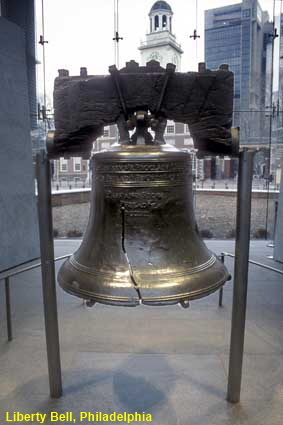
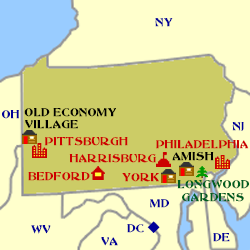
Click on Minimap to navigate
Home > US States > Midatlantic USA >
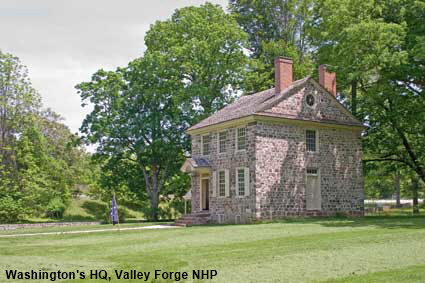
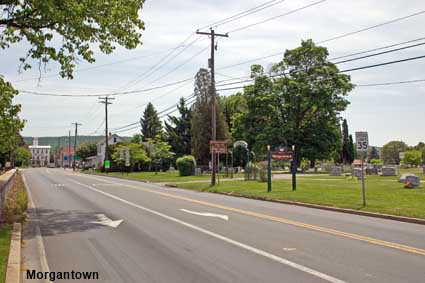
Dr Knisely covered bridge, near Bedford
The countryside around Bedford is well known for its covered bridges. The Dr Knisely bridge was built 1867 and has a span of 24 metres (80 feet). This covered bridge uses a truss invented by Theodore Burr. Burr recognised that conventional timber trusses had reached the limit of span and load that they could handle. To allow for longer spans and heavier loads he added a timber arch to the truss. The Burr Truss was patented in 1804 and it soon became one of the most frequently used designs. Sadly, the Dr Knisely covered bridge is no longer capable of carrying traffic.
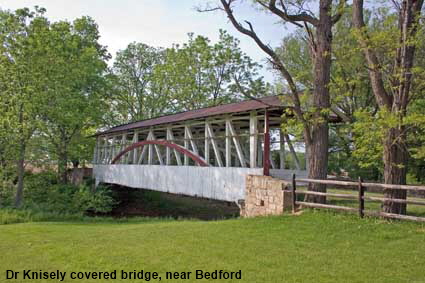
DLU080429


We have other pages on Pennsylvania. Click below or on the Minimap:

© Mike Elsden 1981 - 2025
The contents of this page may not be reproduced in full or in part without permission